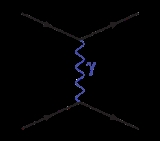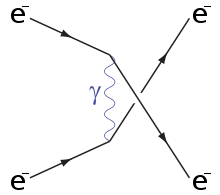
Møller scattering
Encyclopedia
| Feynman diagrams |
|---|
t-channel |
u-channel |
Møller scattering is the name given to electron
Electron
The electron is a subatomic particle with a negative elementary electric charge. It has no known components or substructure; in other words, it is generally thought to be an elementary particle. An electron has a mass that is approximately 1/1836 that of the proton...
-electron scattering in Quantum Field Theory
Quantum field theory
Quantum field theory provides a theoretical framework for constructing quantum mechanical models of systems classically parametrized by an infinite number of dynamical degrees of freedom, that is, fields and many-body systems. It is the natural and quantitative language of particle physics and...
. The electron interaction that is idealized in Møller scattering forms the theoretical basis of many familiar phenomena such as the repulsion of electrons in the Helium nucleus. While formerly many particle colliders were designed specifically for electron-electron collisions, more recently electron-positron colliders have become more common. Nevertheless Møller scattering remains a paradigmatic process within the theory of particle interactions.
In quantum electrodynamics
Quantum electrodynamics
Quantum electrodynamics is the relativistic quantum field theory of electrodynamics. In essence, it describes how light and matter interact and is the first theory where full agreement between quantum mechanics and special relativity is achieved...
, there are two tree-level Feynman diagrams describing the process: a t-channel
Mandelstam variables
In theoretical physics, the Mandelstam variables are numerical quantities that encode the energy, momentum, and angles of particles in a scattering process in a Lorentz-invariant fashion...
diagram in which the electrons exchange a photon
Photon
In physics, a photon is an elementary particle, the quantum of the electromagnetic interaction and the basic unit of light and all other forms of electromagnetic radiation. It is also the force carrier for the electromagnetic force...
and a similar u-channel diagram. Crossing symmetry
Crossing symmetry
In quantum field theory, a branch of theoretical physics, crossing is the property of scattering amplitudes that allows antiparticles to be interpreted as particles going backwards in time....
, one of the tricks often used to evaluate Feynman diagrams, in this case implies that Møller scattering should have the same cross section as Bhabha scattering
Bhabha scattering
In quantum electrodynamics, Bhabha scattering is the electron-positron scattering process:There are two leading-order Feynman diagrams contributing to this interaction: an annihilation process and a scattering process. The Bhabha scattering rate is used as a luminosity monitor in electron-positron...
(electron-positron
Positron
The positron or antielectron is the antiparticle or the antimatter counterpart of the electron. The positron has an electric charge of +1e, a spin of ½, and has the same mass as an electron...
scattering).
In the electroweak theory the process is instead described by four tree-level diagrams: the two from QED and an identical pair in which a Z boson is exchanged instead of a photon. The weak force is purely left-handed, but the weak and electromagnetic forces mix into the particles we observe. The photon is symmetric by construction, but the Z boson prefers left-handed particles to right-handed particles. Thus the cross sections for left-handed electrons and right-handed differ. The difference was first noticed by the Russian physicist Yakov Zel'dovich in 1959, but at the time he believed the parity
Parity (physics)
In physics, a parity transformation is the flip in the sign of one spatial coordinate. In three dimensions, it is also commonly described by the simultaneous flip in the sign of all three spatial coordinates:...
violating asymmetry (a few hundred parts per billion) was too small to be observed. This parity violating asymmetry can be measured by firing a polarized beam of electrons through an unpolarized electron target (liquid hydrogen
Liquid hydrogen
Liquid hydrogen is the liquid state of the element hydrogen. Hydrogen is found naturally in the molecular H2 form.To exist as a liquid, H2 must be pressurized above and cooled below hydrogen's Critical point. However, for hydrogen to be in a full liquid state without boiling off, it needs to be...
, for instance), as was done by an experiment at the Stanford Linear Accelerator Center
Stanford Linear Accelerator Center
The SLAC National Accelerator Laboratory, originally named Stanford Linear Accelerator Center, is a United States Department of Energy National Laboratory operated by Stanford University under the programmatic direction of the U.S...
, SLAC-E158. The asymmetry in Møller scattering is
 ,
,where m is the electron mass, E the energy of the incoming electron (in the reference frame of the other electron),
 is Fermi's constant
is Fermi's constantFermi's interaction
In particle physics, Fermi's interaction also known as Fermi coupling, is an old explanation of the weak force, proposed by Enrico Fermi, in which four fermions directly interact with one another at one vertex...
,
 is the fine structure constant,
is the fine structure constant,  is the scattering angle in the center of mass frame, and
is the scattering angle in the center of mass frame, and  is the weak mixing angle, also known as the Weinberg angle
is the weak mixing angle, also known as the Weinberg angleWeinberg angle
The Weinberg angle or weak mixing angle is a parameter in the Weinberg–Salam theory of the electroweak interaction, and is usually denoted as θW...
.

